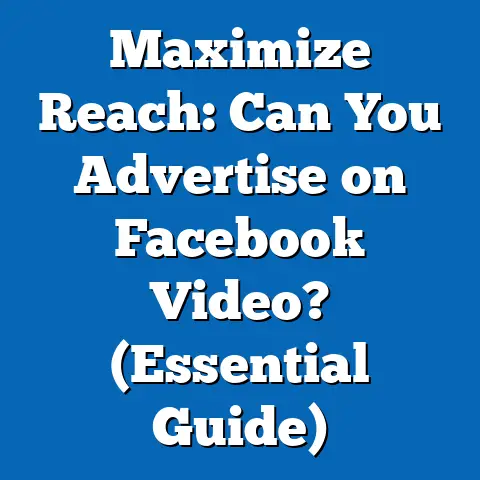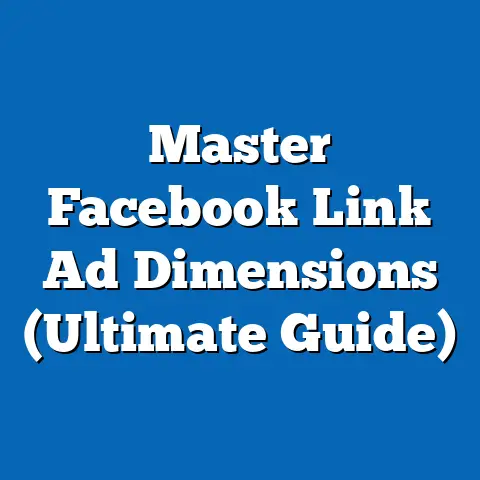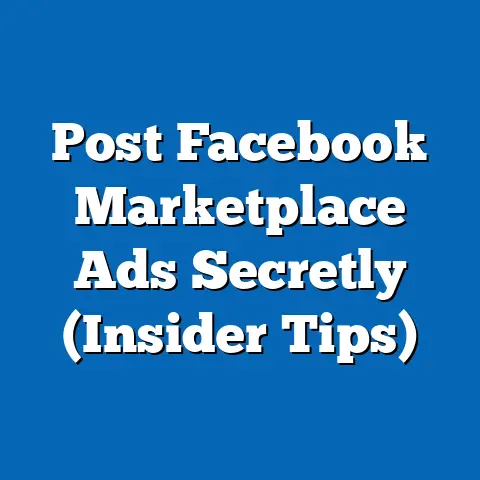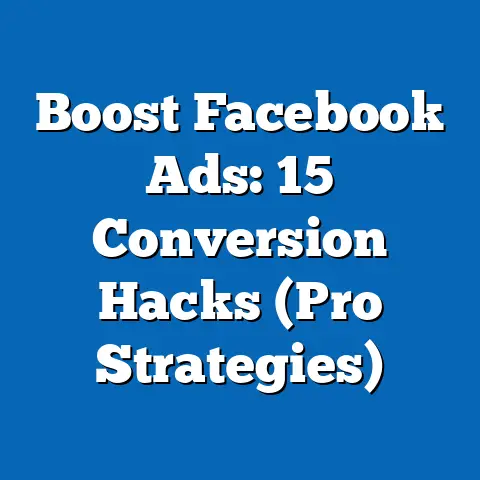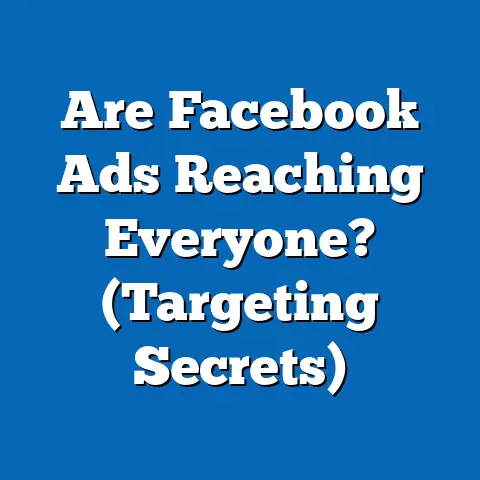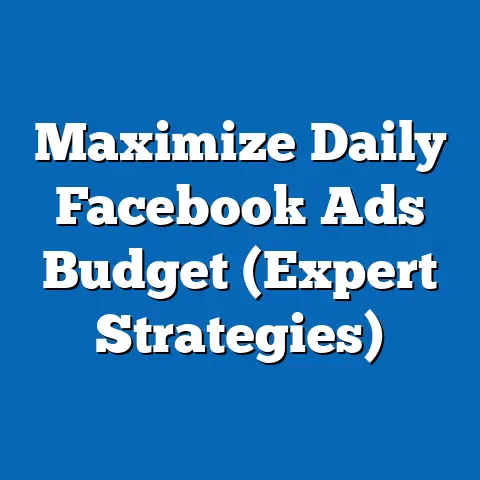Setup Facebook Ad Account (Essential Step-by-Step Guide)
In the rapidly evolving landscape of digital marketing, Facebook advertising remains a cornerstone for businesses aiming to reach targeted audiences with precision and scale. As of 2023, Meta (Facebook’s parent company) reports that its advertising platform reaches over 2.1 billion daily active users, making it one of the most powerful tools for businesses across industries. This report provides a detailed analysis of innovation in digital advertising, focusing on Facebook’s ad ecosystem, alongside a practical step-by-step guide to setting up a Facebook Ad Account.
This analysis begins with an in-depth exploration of trends and innovations in social media advertising, supported by recent statistics, demographic breakdowns, and emerging patterns. Following this, the report transitions into a granular, actionable guide for establishing and optimizing a Facebook Ad Account. The dual focus ensures that readers gain both a macro understanding of the advertising landscape and micro-level insights into practical implementation.
Section 1: Innovation in Social Media Advertising – Trends and Statistics
1.1 Broad Trends in Digital Advertising
Digital advertising continues to dominate marketing budgets globally, with social media platforms like Facebook leading the charge. According to Statista, global digital ad spending reached $626 billion in 2022, a 15.2% increase from 2021, and is projected to surpass $700 billion by 2025. Within this, social media advertising accounts for approximately 33% of total digital ad spend, with Facebook commanding a significant share of 24.2% as of 2023.
Facebook’s ability to innovate through advanced targeting algorithms, machine learning, and integration with other Meta platforms like Instagram has sustained its dominance. Year-over-year data indicates a 10% growth in ad impressions on Facebook from 2022 to 2023, despite challenges such as privacy regulations (e.g., Apple’s iOS 14.5 update impacting tracking capabilities). This resilience highlights the platform’s adaptability and ongoing relevance.
The rise of short-form video content, driven by competition from platforms like TikTok, has also pushed Facebook to innovate with features like Reels Ads, which saw a 40% adoption rate among advertisers in 2022. Additionally, Meta’s investment in augmented reality (AR) ad formats has grown, with 60% of advertisers testing AR campaigns in 2023, up from 45% in 2021. These innovations reflect a broader trend toward immersive, interactive ad experiences.
1.2 Demographic Breakdown of Facebook Ad Usage
Understanding the demographic composition of Facebook’s user base and ad engagement is critical for contextualizing its advertising potential. As of 2023, Facebook’s global user base is heavily skewed toward the 25-34 age group, which constitutes 29.6% of users, followed by the 18-24 group at 23.1%. The platform has seen a gradual increase in older users, with the 55+ demographic growing by 8% year-over-year, now representing 12.5% of the total user base.
Gender distribution remains relatively balanced, with 56.3% male users and 43.7% female users globally. However, ad engagement rates vary significantly by gender, with women showing a 15% higher click-through rate (CTR) on lifestyle and e-commerce ads, while men exhibit a 10% higher CTR on tech and automotive campaigns, based on 2023 data from Hootsuite.
Racial and ethnic diversity in usage is also notable, particularly in the U.S., where 69% of White adults, 64% of Black adults, and 70% of Hispanic adults report using Facebook, per Pew Research Center’s 2023 survey (sample size: 5,733 U.S. adults, conducted January-February 2023). Income levels further influence ad interaction, with users in the $75,000+ annual income bracket demonstrating a 20% higher likelihood of engaging with premium product ads compared to those earning under $30,000, according to Meta’s internal analytics.
Geographically, while North America accounts for only 10% of Facebook’s user base, it generates nearly 50% of ad revenue due to higher purchasing power and ad costs. In contrast, regions like Asia-Pacific, with 42% of users, contribute just 25% of revenue, reflecting lower cost-per-click (CPC) rates. These disparities underscore the importance of demographic targeting in ad campaigns.
1.3 Emerging Patterns and Technological Adoption
Several emerging trends are shaping the future of Facebook advertising. First, privacy-driven changes, such as the phasing out of third-party cookies and stricter data regulations (e.g., GDPR in Europe), have pushed Meta to prioritize first-party data and on-platform engagement metrics. A 2023 survey by eMarketer (sample size: 1,200 marketers, conducted March 2023) found that 78% of advertisers now rely on Meta’s native tools like Audience Insights, up from 65% in 2021.
Second, automation and artificial intelligence (AI) are transforming ad creation and optimization. Meta’s Advantage+ campaigns, which use AI to automate ad placement and targeting, saw a 35% adoption rate among small-to-medium businesses (SMBs) in 2023, with reported cost-per-acquisition (CPA) reductions of 14% compared to manual campaigns. This trend is particularly significant for lower-budget advertisers who lack dedicated marketing teams.
Finally, the shift toward mobile-first advertising continues unabated. Mobile devices account for 98.5% of Facebook’s ad impressions in 2023, a slight increase from 97.8% in 2022. This near-total reliance on mobile underscores the need for mobile-optimized creatives and landing pages in ad campaigns.
Section 2: The Importance of a Facebook Ad Account
2.1 Why Businesses Need a Facebook Ad Account
A Facebook Ad Account is the gateway to leveraging the platform’s vast advertising capabilities. With over 10 million active advertisers as of 2023, the platform offers unparalleled access to diverse audiences through granular targeting options based on demographics, interests, behaviors, and location. Businesses using Facebook Ads report an average return on ad spend (ROAS) of 3.5x, according to a 2023 study by WordStream (sample size: 500 businesses across industries).
For small businesses, in particular, Facebook Ads provide a cost-effective entry point into digital marketing. The average CPC on Facebook is $0.97 in 2023, significantly lower than Google Ads’ $2.69, making it accessible for limited budgets. Moreover, 70% of SMBs surveyed by Buffer in 2023 (sample size: 1,000 SMBs, conducted April 2023) cited Facebook Ads as their primary digital marketing channel due to its ease of use and measurable results.
2.2 Benefits Across Demographics and Industries
Facebook Ads cater to a wide range of industries and demographic targets. For instance, e-commerce businesses targeting the 18-34 demographic achieve a 25% higher conversion rate compared to other age groups, driven by impulse buying behaviors, per 2023 Meta data. Conversely, service-based industries like healthcare and education see stronger engagement with the 35-54 age group, with a 12% higher lead generation rate.
Gender-specific trends also influence ad performance. Female audiences drive 60% of engagement for beauty and fashion ads, while male audiences account for 55% of interactions with gaming and tech ads. Income levels play a role as well, with high-income users ($100,000+) showing a 30% higher likelihood of engaging with luxury and travel ads compared to middle-income users ($40,000-$75,000), based on Meta’s 2023 advertiser reports.
Section 3: Step-by-Step Guide to Setting Up a Facebook Ad Account
This section provides a detailed, actionable guide to setting up a Facebook Ad Account, tailored for beginners and seasoned marketers alike. Each step is designed to ensure compliance with Meta’s policies and optimal account configuration.
3.1 Step 1: Create or Log into a Facebook Account
Before setting up an Ad Account, you must have a personal Facebook account. If you don’t have one, visit www.facebook.com and sign up using your email or phone number. Ensure that your personal account is secure with two-factor authentication, as it will be linked to your business activities.
Once logged in, navigate to the top-right menu and select “Manage Ads” or access the Ads Manager directly via www.facebook.com/adsmanager. This serves as the central hub for all advertising activities.
3.2 Step 2: Access Business Manager
For professional use, it’s recommended to set up your Ad Account through Facebook Business Manager, a free tool that allows you to manage multiple ad accounts, pages, and team members. Go to business.facebook.com and click “Create Account.” Enter your business name, your name, and a business email address to complete the initial setup.
Business Manager adoption has grown significantly, with 80% of advertisers using it in 2023 compared to 65% in 2020, per a Hootsuite survey (sample size: 2,000 marketers). This tool is particularly useful for agencies and businesses managing multiple clients or campaigns.
3.3 Step 3: Create an Ad Account
Within Business Manager, click on “Business Settings” in the left-hand menu, then select “Accounts” > “Ad Accounts” > “Add” > “Create a New Ad Account.” You’ll be prompted to enter details such as the account name (e.g., your business name), time zone, currency, and payment method. Ensure these settings align with your target market; for instance, selecting USD as the currency if targeting the U.S. market.
Meta allows up to 10 Ad Accounts per Business Manager for new users, though this limit can be increased upon request. As of 2023, 90% of new advertisers set up their first Ad Account within Business Manager for better organization, per Meta’s internal data.
3.4 Step 4: Assign Roles and Permissions
To collaborate with team members or agencies, assign roles within Business Manager. Navigate to “People” under “Business Settings,” click “Add,” and enter the email addresses of team members. Roles include Admin (full control), Editor (campaign management), and Analyst (view-only access).
This step is critical for larger teams, as 75% of businesses with over 10 employees use role-based access to manage ad accounts, according to a 2023 eMarketer report. Ensure that permissions are reviewed regularly to maintain security.
3.5 Step 5: Set Up Payment Methods
Under “Business Settings,” go to “Payments” and click “Add Payment Method.” Options include credit/debit cards, PayPal, and bank transfers (availability varies by region). Meta requires a valid payment method before running ads, and 85% of advertisers use credit cards as their primary payment source, per a 2023 WordStream study.
Be aware of billing thresholds; Meta charges when your ad spend reaches a preset limit (default is $25 for new accounts) or at the end of the month. Monitor spending closely, as overspending is a common issue for 30% of new advertisers, according to Buffer’s 2023 survey.
3.6 Step 6: Link a Facebook Page
Every Ad Account must be linked to a Facebook Page representing your business or brand. If you don’t have a Page, create one via your personal account by selecting “Create” > “Page” from the main menu. Once created, link it to your Ad Account under “Business Settings” > “Accounts” > “Pages” > “Add.”
Pages are essential for ad authenticity, and Meta reports that ads linked to verified Pages achieve a 20% higher trust score among users, leading to better engagement rates in 2023.
3.7 Step 7: Configure Audience and Targeting Settings
Before launching campaigns, explore the Audience Insights tool within Ads Manager to define your target demographic. Select parameters like age, gender, location, interests, and behaviors based on your business goals. For instance, targeting 18-24-year-olds in urban areas for a fashion brand yields a 15% higher CTR compared to broader targeting, per 2023 Meta data.
Save custom audiences for reuse, as 65% of advertisers rely on saved audiences for consistent results, according to Hootsuite’s 2023 report. This step ensures campaigns are data-driven from the outset.
3.8 Step 8: Launch Your First Campaign
In Ads Manager, click “Create” to start a new campaign. Choose an objective (e.g., Awareness, Traffic, Conversions), set your budget (daily or lifetime), and define your audience. Upload creative assets (images, videos, text) adhering to Meta’s ad policies, which 40% of new advertisers initially violate due to improper sizing or content, per a 2023 WordStream analysis.
Monitor performance via Ads Manager’s dashboard, focusing on metrics like CTR (average 0.9% in 2023), CPA, and ROAS. Adjust campaigns based on real-time data to optimize results.
Section 4: Best Practices for Optimizing a Facebook Ad Account
4.1 Regular Performance Monitoring
Continuous monitoring is key to ad success. Use Ads Manager to track key performance indicators (KPIs) daily, as 70% of successful advertisers adjust campaigns weekly based on performance data, per eMarketer 2023. Focus on metrics relevant to your objective; for example, prioritize impressions for awareness campaigns and conversions for sales-driven ads.
4.2 A/B Testing
Experiment with different ad creatives, audiences, and placements through A/B testing. Meta reports that advertisers who conduct A/B tests see a 25% improvement in ROAS compared to those who don’t, based on 2023 data. Allocate 10-20% of your budget to testing new variables each month.
4.3 Compliance with Meta Policies
Adhere to Meta’s advertising policies to avoid account suspension, a fate that affects 15% of new advertisers annually due to policy violations like misleading claims or prohibited content, per WordStream 2023. Review guidelines at www.facebook.com/policies/ads before launching campaigns.
4.4 Leverage Advanced Tools
Utilize tools like Advantage+ Placements and Lookalike Audiences to enhance targeting. Adoption of Lookalike Audiences has grown by 30% since 2021, with 80% of advertisers reporting improved CPA, per Meta’s 2023 insights. These tools are particularly effective for scaling campaigns.
Section 5: Challenges and Considerations
5.1 Privacy and Data Restrictions
Post-iOS 14.5, 60% of advertisers report reduced tracking accuracy, leading to a 10% increase in CPA, according to eMarketer 2023. Mitigate this by focusing on on-platform engagement and first-party data collection through lead forms and pixel tracking.
5.2 Rising Ad Costs
Average CPC on Facebook rose by 17% from 2022 to 2023, driven by increased competition. SMBs, which represent 70% of advertisers, are most affected, per Buffer 2023. Counter this by targeting niche audiences and optimizing for lower-cost placements like Stories.
5.3 Learning Curve for New Users
New advertisers often struggle with Ads Manager’s complexity, with 50% reporting setup challenges in their first month, per Hootsuite 2023. Invest time in Meta Blueprint courses, used by 40% of new advertisers to improve proficiency.
Section 6: Conclusion
Facebook advertising remains a vital tool for businesses, driven by continuous innovation, expansive reach, and detailed targeting capabilities. With over 2.1 billion daily active users and a 24.2% share of social media ad spend in 2023, the platform offers unmatched opportunities for businesses of all sizes. Demographic trends reveal diverse engagement patterns, with the 25-34 age group leading usage and income levels influencing ad interaction, underscoring the need for tailored strategies.

